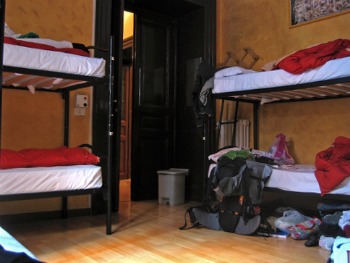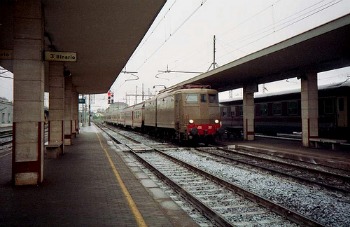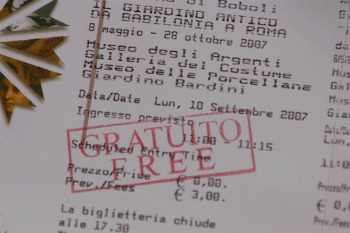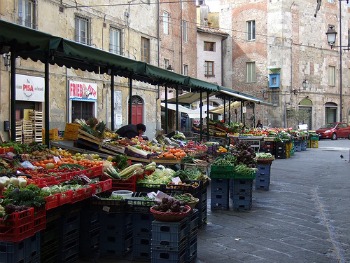Italy on a Budget
 After recently putting together an in-depth guide to planning an Italy travel budget, I wanted to follow up with some ideas for ways to make your visit to Italy cost less than the average.
After recently putting together an in-depth guide to planning an Italy travel budget, I wanted to follow up with some ideas for ways to make your visit to Italy cost less than the average.
It’s not news to many people to hear that Italy isn’t exactly a cheap destination to travel in anymore. It used to be, and some places are still amazingly affordable, but overall it can be a country that’s harder for serious budget travelers to love. Sacrificing now and then to stay on your travel budget is one thing, but cutting things off your to-do list every day is a bummer.
In this article, you’ll find resources to help make your Italy trip cheaper – whether you’re trying to avoid skipping the country altogether on a round-the-world trip or you just like saving money on your trips no matter how long you’re traveling. Some of the tips listed do require that you’re a bit more of an intrepid traveler who’s willing to forgo certain luxuries, but others are things a traveler with any budget can do and enjoy.
Click on any of the following links to jump to the category you want to read more about:
- Getting to Italy Cheaply
- Cheap Accommodation in Italy
- Getting Around Italy Cheaply
- Cheap Things to Do in Italy
- Eating Cheap in Italy
Getting to Italy on the Cheap
 Budget travel to Italy begins with finding a good deal on airfare, and unfortunately this is sometimes a challenge for anyone outside continental Europe. Looking up fares for flights from New York to Paris, Amsterdam, and Rome often demonstrates that flights to Italy are almost always more expensive than flights into other big European hubs. I’ve never read a satisfactory explanation of why this is, and even if there was a reasonable explanation it wouldn’t make the prices go down – so it’s something budget travelers need to contend with.
Budget travel to Italy begins with finding a good deal on airfare, and unfortunately this is sometimes a challenge for anyone outside continental Europe. Looking up fares for flights from New York to Paris, Amsterdam, and Rome often demonstrates that flights to Italy are almost always more expensive than flights into other big European hubs. I’ve never read a satisfactory explanation of why this is, and even if there was a reasonable explanation it wouldn’t make the prices go down – so it’s something budget travelers need to contend with.
Here are a couple tips to finding cheaper airfare to Italy:
- Travel to Italy during the low season or the shoulder seasons – Italy’s high season, roughly May through September, means prices on airfare (and other things) go way up. If you visit during the winter you can often find serious bargains on flights, and in the shoulder seasons (March–April and October–November) there are deals that are quite good when the weather has a chance of being warmer than the winter months.
- Fly into Italy via a different country – As mentioned above, flights to big hubs in Europe (such as Amsterdam, Frankfurt, and Paris) are often cheaper than flights to Italy. If you happen to find a killer deal on a flight to another city in Europe, you can then buy a separate ticket from there to whatever city in Italy you want to be in – and you can then fly on one of the budget airlines in Italy which sometimes have incredibly low fares available. This does require two distinct itineraries, as the two airlines don’t know about the other flight, so you’ll have to collect any checked bags at your first European stop and re-check them for the next leg, but if the price is right the hassle is minimal.
Further reading:
>> Look for cheap tickets to Paris, deals to London, cheap flights to Amsterdam, and deals to Frankfurt
Cheap Accommodation Options in Italy
 Italy’s status as a top-tier tourist destination means there’s all manner of accommodation for you to choose from almost everywhere you want to go. It also means that lodging in the most-visited cities isn’t cheap. Rather than cut destinations like Rome, Venice, and Florence from your itinerary, however, you can cut costs on your accommodation in popular places by broadening the scope of the kinds of places you’ll stay in or the neighborhoods you’ll consider.
Italy’s status as a top-tier tourist destination means there’s all manner of accommodation for you to choose from almost everywhere you want to go. It also means that lodging in the most-visited cities isn’t cheap. Rather than cut destinations like Rome, Venice, and Florence from your itinerary, however, you can cut costs on your accommodation in popular places by broadening the scope of the kinds of places you’ll stay in or the neighborhoods you’ll consider.
Here are some tips to sleeping cheap in Italy:
- Look at alternatives to traditional hotels – Yes, Italy has traditional hotels, including some of the big worldwide chains. Often, however, the cheaper accommodation options aren’t hotels (this is especially true in more touristed cities). Hostels can be an excellent option in cities that have them; and don’t be fooled by the old-fashioned term “youth hostel,” as these places almost never have age restrictions anymore. You’ll save big by booking a bed in a dorm, but many have private rooms these days so you can have your privacy and still take advantage of lower prices for your room. In smaller cities and less-visited areas, budget-friendly options will include hotels but they’ll sometimes be listed under “hostels” on booking sites because of their pricetag. The B&B isn’t as pervasive in Italy as it is in a country like England, but many small hotels are family-run and feel quite like a B&B in many ways. If you’re staying long enough in one place (or if you’re traveling with a family or friends), renting an apartment for a few days can be a great budget choice. Finally, in more rural areas look for agriturismo (farm stay) options.
- Look for lodging that’s not right in the middle of everything – Having a hotel room with a view of the Colosseum in Rome sounds wonderful, and it probably won’t surprise you to know that rooms like that are costly. Your wallet will take less of a hit if you’re looking for accommodation that’s not right on the main square, just a block from the biggest attraction in town, etc. You’ll need to walk a bit further to see the sights, and might even need to hop on public transportation to get where you want to go, but public transport is usually cheap enough that even that expense won’t negate the savings in lodging that’s away from tourist central. Another thing to consider is if you still want a hotel with a good location but you want a cheaper room, find out if the places you’re looking at have rooms facing something less-than-picturesque (such as an alley behind the hotel) that may have cheaper rates.
- Forgo the usual luxuries – There are some things you might take for granted in hotels when you travel, but some of them will cause the price of your Italy accommodation to go up. Can you live without things like elevators in the building, private or en suite bathrooms, and staff at the front desk 24 hours a day? If so, you might save quite a bit. Even something like a basic breakfast buffet in some hotels will cost extra, and getting something comparable (and sometimes tastier) at a corner bar is cheaper.
Further reading:
- What Accommodation Terms in Italy Mean
- Finding Cheap Hotels in Italy
- What Hotel Stars Mean in Italy
- Finding Cheap Hostels in Italy
- Camping in Italy Doesn’t Mean Bringing Your Own Tent
- Renting an Apartment in Italy for a Short-Term Stay
- Agriturismo in Italy
Cheap Transportation in Italy
 Getting from place to place once you get to Italy can be fairly inexpensive, as long as you’ve got time to spare to take advantage of the lower prices on slower transportation. There are some times when I think splurging on a taxi ride makes sense, but more often than not there’s a cheaper alternative that’s easy enough for everyone to use. Renting a car is sometimes necessary, depending on where you want to go, and even those costs can be mitigated.
Getting from place to place once you get to Italy can be fairly inexpensive, as long as you’ve got time to spare to take advantage of the lower prices on slower transportation. There are some times when I think splurging on a taxi ride makes sense, but more often than not there’s a cheaper alternative that’s easy enough for everyone to use. Renting a car is sometimes necessary, depending on where you want to go, and even those costs can be mitigated.
Here are some tips to getting around Italy on the cheap:
- Take the slow train – There are some great high-speed trains in Italy, but the faster trains are the most expensive tickets. There’s always a slower option between the two points on your itinerary (it’s slower both because it’s an older train and also because it makes more stops along the way), and that will always be the cheaper ticket. If you’ve got time to play with, ask the person at the ticket window what the cheapest train is.
- Stick to second class – Most Italian trains have two classes of cars, and while traveling in first class sounds nice the reality is that the differences between the two on many trains are minimal. This is especially true on the high-speed or newer trains, where second class is quite nice. On slower trains, there’s more of a difference, but it’s not like Italy’s trains have such a dichotomy between the classes that one is like the Ritz-Carlton and the other is like a chicken bus. The train will still get you there in the same amount of time, regardless of which car you’re in.
- Figure out whether a Rail Pass will save you money – If your Italy itinerary will require any long-distance (including overnight) trains or high-speed trains, it’s wise to do the math to find out whether buying an Italy Rail Pass before you leave home will save you money over buying point-to-point tickets individually. A general rule of thumb is that you’ll save money if you’re taking lots of those expensive trains (high-speed, long-distance, overnight) and that you won’t if you’re always taking the slow train, but the only way to know for sure is to dust off the calculator.
- Book train tickets in advance – If you find that buying individual tickets is the cheaper alternative for you, and if you have an itinerary that’s set before you leave, you can save quite a bit by booking your train tickets ahead of time. The Italian train service offers discounts (sometimes up to 30% off the regular ticket price) for advance purchases, but those without Italian credit cards can’t purchase directly from their site. You can book Italy train tickets and get those same discounts right here on WhyGo Italy, however, using the booking tool at the right. Of course, if your itinerary is entirely unplanned, this won’t work for you.
- Within one region, look into taking the bus – Traveling from one region to another by bus in Italy is a pain, since there isn’t a national bus company, but within one region you can often get from city to city extremely cheaply by taking the bus. Some routes are even more convenient by bus than train (Florence to Siena, for instance).
- Get a diesel car with a manual transmission – If you’re renting a car, the two things you should look at that will impact the cost of a car rental are the type of fuel the car uses and the type of transmission it has. Cars that run on diesel will cost you significantly less in fuel expenses over the duration of your trip, and cars with a manual transmission cost far less to rent than automatics.
var Company = “BNUS”;
var AgencyID = “”;
var Country = “US”;
var SubmitURL=”https://cart.railkey.com”;
ShowBookingWidget();
Further reading:
- Italy Trains Guide
- When to Buy an Italy Rail Pass
- When to Buy Italy Rail Tickets
- How to Buy Italy Rail Tickets (including how to get those great advance-purchase discounts)
- 1st and 2nd Class on Italian Trains
- Italy Bus Travel Guide
- Renting a Car in Italy
Finding Cheap Things to Do in Italy
 Even though paying €10 for a ticket to a museum in Italy may seem like small potatoes compared to the several hundred you paid for your airline ticket, those entry fees can really add up. Finding cheap things to do in Italy can be the difference between enjoying your whole trip or running out of money halfway through your trip.
Even though paying €10 for a ticket to a museum in Italy may seem like small potatoes compared to the several hundred you paid for your airline ticket, those entry fees can really add up. Finding cheap things to do in Italy can be the difference between enjoying your whole trip or running out of money halfway through your trip.
Here are some tips to help you save money on activities and attractions in Italy:
- Find out about discount passes – Many cities, especially the biggest tourist destinations, have combination passes or cards that offer discounts on attractions and transportation. Whether they’re right for you depends on whether you were planning to visit enough of the included sights to get the full benefit, but some simple math is all it takes to figure out if a discount card will save you money. Even if the town you’re visiting doesn’t have a discount card good for attractions, it may have a multi-use transportation card that will make using public transit in that place cheaper. It’s always worth asking at the tourist information office.
- Look for free stuff to do – Every Italian city has some attractions that don’t charge an entry fee no matter what day it is, and the more of these that you include in your itinerary the easier it is to cut down on daily expenses. Sometimes these free attractions are things you’ve never heard of, and other times they’re some of the main things to do – either way, pay attention to the free sights wherever you are.
- Plan for splurges in advance – There are some big-deal sights that you’d be unhappy about missing, so be sure you know how much admission is before you show up and get sticker shock at the ticket window. Also note that some of those big-deal sights are included in the aforementioned discount passes, and you can sometimes get a better deal if you visit those expensive sights earlier rather than later (for instance, if the first two sights on a card are free and the rest are 50% off, you visit the most expensive sights first to get the most bang for your buck).
- Take advantage of free entry days – Some major attractions that usually charge admission have certain days on which entry is free. The Vatican Museums, for instance, offer free entry on the last Sunday of every month. If you can get in on these free days, it’ll save you money – but be warned that crowds tend to be bigger on free days simply because they’re free, so you may have to wait in a longer line to get in. There are also annual events like Open Monuments Weekend when attractions are free, so check the calendar of events for your destinations to find out if there are any such events going on when you’re going to be there (or ask at the tourist information office when you arrive).
- Get up early and get in line – Speaking of lines, there are lots of great tips on WhyGo Italy and elsewhere about avoiding long lines at big museums, many of which involve booking tickets in advance. Those advance-booking services usually cost a few euro, however, and if you’re really watching your budget that’s a few euro you don’t need to spend. You can still avoid waiting in long lines by getting up early and queuing up before a museum opens – yes, this does mean you’re waiting in a line, but it’s not the 5-6 hour waits outside the Uffizi in the hot sun of Florence I’ve heard people complain about.
Further reading:
Eating Cheap in Italy
 For some (myself included), eating in Italy is one of the great pleasures of traveling through the country. The good news for budget travelers who also happen to be foodies is that eating well for very little money is not only possible in Italy, it’s pretty easy.
For some (myself included), eating in Italy is one of the great pleasures of traveling through the country. The good news for budget travelers who also happen to be foodies is that eating well for very little money is not only possible in Italy, it’s pretty easy.
Here are some tips for eating on the cheap in Italy:
- Eat where the locals eat – In the more touristy cities (and sometimes in less touristy cities) you’ll find plenty of places with menus translated into several languages. These aren’t for the locals, as you might imagine, and not only is the food likely to be mediocre the prices are likely to be higher. Get away from the main tourist thoroughfare to find the places with Italian-only menus where the clientele is at least mostly Italian, and you stand a better chance of getting better food that costs less.
- Skip the table with a view – Restaurants on the main square of a town or with any kind of view worth writing home about will have higher pricetags on everything on the menu. The people-watching may be fantastic from the cafes on St. Mark’s Square in Venice, but even a coffee there will set you back a staggering amount. Again, just getting away from the main tourist areas will lead you to places that may not have a view but are apt to have lower prices and better food.
- Eat breakfast like the Italians – Italian breakfasts consist of a coffee and a pastry, usually consumed in a few quick minutes at a favorite bar between home and work. By following suit, you’re not only pretending to be a local (which is always fun), you’re getting a quick meal for a few euro.
- Sip standing up – Most Italian bars have two price structures – one for people who stand at the counter and another for those who sit at tables. The tables cost more in these situations, so you can save yourself a euro or two just by standing at the counter to have your coffee.
- Eat big at lunch – Since dinner menu prices are almost always higher than lunch menu prices, you can save money by eating your biggest meal at lunch rather than dinner. Get a smaller meal at dinner not only costs less overall, it saves room for an extra scoop of gelato during your post-meal walk through town.
- Cook a few meals – Anyone who’s got a kitchen at their disposal would be smart to use it – whether it’s in an apartment rental or it’s the common kitchen at the hostel, cooking even one meal every other day will save you quite a bit. This also gives you an opportunity to seek out the fantastic outdoor food markets that spring up in towns throughout Italy every day.
- Shop at the markets and go on picnics – Speaking of finding the outdoor food markets, you can still enjoy shopping for goodies at the market if you don’t have a kitchen to cook in by using them as the place to pick up picnic provisions. Most markets will have vendors selling fruit, bread, cheese, and cured meats – any combination of which makes for a delightful picnic meal whether it’s in a pretty park or in your hotel room. If you’ve got a corkscrew and a bottle of wine, all the better.
- Get the house wine – Getting the house wine at a restaurant means your wine will come in a carafe rather than a bottle with a fancy label, but the house wine is almost always incredibly good and cheap (sometimes cheaper than bottled water).
Further reading:
- Different Kinds of Restaurants in Italy
- Tipping in Italy
- Italy Menu Tips
- How to Shop at Italian Markets
- Aperitivo in Italy: How to Eat for Free (Kind Of)
photos, top to bottom, by: Nils Geylen, JackBet, mararie, Hunter-Desportes, Old Fogey 1942, sebrenner